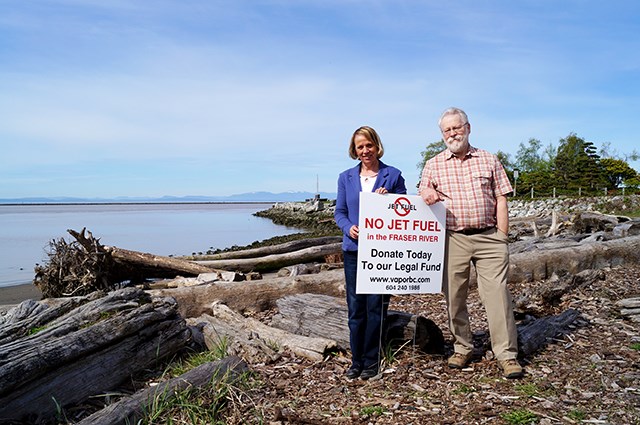VAPOR, a grassroots society opposed to a planned jet fuel storage facility on the Fraser River and pipeline through Richmond, filed for a judicial review of the enviornmental assessment process that granted an environmental certificate to an airlines consortium (VAFFC) for the projects. The group opposes jet fuel tankers on the Fraser River and recommends expanding an existing pipeline to a marine terminal on Burrard Inlet. You can read more about the story and process by clicking on links found at the bottom of the story. Here is their statement, posted April 30:
"VAPOR and Otto Langer are not opposed to the operations at YVR and the need for a secure and safe supply of jet fuel for YVR.
The Fraser River is a unique and internationally important river and over thousands of years it has created a globally significant estuary. It is still home to the world’s largest salmon runs in a river and its estuary is home to some of the largest migratory and overwintering bird populations in the Americas.
In 1988 VAFFC applied to put jet fuel barges and a terminal into the North Arm of the Fraser River. After days of public panel hearings it was rejected by the Federal government as too great a risk to the Fraser River and its estuary.
Since about 2006 VAFFC has been planning to put jet fuel barges and tankers into the Fraser River to supply cheaper offshore fuel to YVR. In about 2008 they bought a parcel of land immediately upstream to the RiverPort Entertainment and Recreational complex and the Waterstone Pier residential complex – only 400m from the jet fuel dock.
Here they proposed to build a large jet fuel storage facility(will store up to 80 million litres of jet fuel), a fuel off loading terminal and have barges and Panamax supertankers travel some 21km up the river from Sandheads to that facility. The fuel would reach YVR by the construction of a new pipeline across Richmond.
Due to a lack of Federal or BC law trigger for a full public open and transparent environmental review, VAFFC asked the BC EAO to do a voluntary one. It was accepted as such and Port Metro Vancouver joined the BC EAO in a co-operative Environmental Assessment .
VAFFC did not seriously look at other more environmentally friendly, more reliable and safer options – they were summarily dismissed and they insisted they had to stay with the option to put supertankers into the Fraser River – they insist it was the cheapest way to get fuel to YVR. Public had no say on selection of this option and environmental considerations were not considered as a major determining factor.
In Jan 2011, the VAFFC application was accepted for an EA by BC EAO for an Environmental Certificate (as noted above --- to permit barges and tankers of toxic and flammable jet fuel to enter the South Arm (Main Arm) of the Fraser River, build a terminal, tank farm and a pipeline across Richmond). The facility was to be on the bank of the Fraser River near the Riverport entertainment and recreational complex and the Waterstone Pier residential complex).
It is well known that jet fuel was highly toxic to aquatic life, could easily contaminate habitat for long period of time and was flammable and could cause a destructive explosion. It was a high risk to the river, its life and public safety. VAFFC predicted a significant probability of spills into the river.
The Executive Director of BC EAO said
“a. The project had the potential to result in significant adverse environmental, economic, health, heritage and social effects; and
b. Strong public interest was anticipated and a clear, transparent environmental assessment process would be in the public interest.”
The BC EAO Executive Director’s considerations was of course to be ruled by natural justice and procedural fairness.
The public consultation was delegated to the proponent VAFFC.
The consultations got off on the wrong foot and persisted as such for the entire review process of over 1000 days. The flawed consultation product was used to prepare the Environmental Assessment report and that was used by the Ministers Polak and Coleman to issue the Environmental Certificate 4 months ago.
A few examples of what went wrong.
- Notification was flawed – mainly to industrial groups – public largely ignored.
- Short and poor notice and large volumes of studies - 1500 pages for public – impossible to address in short review period.
- In Feb 2012 open house held at the end of the public comment period.
- Notice was short and advertisements inadequate – e.g. legal ad in a Clip and Save flier.
- Consultations were not adequate in that they were not meaningful -- they did not seriously consider public input.
- No written report by the Executive Director on the adequacy of the consultations.
VAPOR and Otto Langer argue that they were denied natural justice and procedural fairness in this matter as related to relevant legal principles and laws in the public consultation process.
Remedies sought:
- Quash the Environmental Assessment report that allowed the Environmental Certificate to be issued.
- Quash the Environmental Certificate. "
@WestcoastWood



